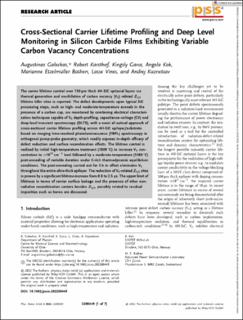| dc.contributor.author | Galeckas, Augustinas | |
| dc.contributor.author | Karsthof, Robert Michael | |
| dc.contributor.author | Gana, Kingsly | |
| dc.contributor.author | Kok, Angela | |
| dc.contributor.author | Bathen, Marianne Etzelmüller | |
| dc.contributor.author | Vines, Lasse | |
| dc.contributor.author | Kuznetsov, Andrej | |
| dc.date.accessioned | 2023-02-21T14:46:09Z | |
| dc.date.available | 2023-02-21T14:46:09Z | |
| dc.date.created | 2022-11-28T18:18:46Z | |
| dc.date.issued | 2022 | |
| dc.identifier.citation | Physica Status Solidi (a) applications and materials science. 2022, 2200449. | en_US |
| dc.identifier.issn | 1862-6300 | |
| dc.identifier.uri | https://hdl.handle.net/11250/3052844 | |
| dc.description.abstract | The carrier lifetime control over 150 μm thick 4H-SiC epitaxial layers via thermal generation and annihilation of carbon vacancy (VC) related Z1/2 lifetime killer sites is reported. The defect developments upon typical SiC processing steps, such as high- and moderate-temperature anneals in the presence of a carbon cap, are monitored by combining electrical characterization techniques capable of VC depth-profiling, capacitance–voltage (CV) and deep-level transient spectroscopy (DLTS), with a novel all-optical approach of cross-sectional carrier lifetime profiling across 4H-SiC epilayer/substrate based on imaging time-resolved photoluminescence (TRPL) spectroscopy in orthogonal pump-probe geometry, which readily exposes in-depth efficacy of defect reduction and surface recombination effects. The lifetime control is realized by initial high-temperature treatment (1800 °C) to increase VC concentration to ≈1013 cm−3 level followed by a moderate-temperature (1500 °C) post-annealing of variable duration under C-rich thermodynamic equilibrium conditions. The post-annealing carried out for 5 h in effect eliminates VC throughout the entire ultra-thick epilayer. The reduction of VC-related Z1/2 sites is proven by a significant lifetime increase from 0.8 to 2.5 μs. The upper limit of lifetimes in terms of carrier surface leakage and the presence of other nonradiative recombination centers besides Z1/2, possibly related to residual impurities such as boron are discussed. | en_US |
| dc.language.iso | eng | en_US |
| dc.publisher | Wiley | en_US |
| dc.relation.uri | https://onlinelibrary.wiley.com/doi/10.1002/pssa.202200449 | |
| dc.rights | Navngivelse 4.0 Internasjonal | * |
| dc.rights.uri | http://creativecommons.org/licenses/by/4.0/deed.no | * |
| dc.title | Cross-Sectional Carrier Lifetime Profiling and Deep Level Monitoring in Silicon Carbide Films Exhibiting Variable Carbon Vacancy Concentrations | en_US |
| dc.title.alternative | Cross-Sectional Carrier Lifetime Profiling and Deep Level Monitoring in Silicon Carbide Films Exhibiting Variable Carbon Vacancy Concentrations | en_US |
| dc.type | Peer reviewed | en_US |
| dc.type | Journal article | en_US |
| dc.description.version | publishedVersion | en_US |
| dc.rights.holder | © 2022 The Authors | en_US |
| dc.source.pagenumber | 7 | en_US |
| dc.source.journal | Physica Status Solidi (a) applications and materials science | en_US |
| dc.identifier.doi | 10.1002/pssa.202200449 | |
| dc.identifier.cristin | 2083113 | |
| dc.relation.project | Norges forskningsråd: 245963 | en_US |
| dc.relation.project | Norges forskningsråd: 325573 | en_US |
| dc.relation.project | Norges forskningsråd: 251131 | en_US |
| dc.relation.project | Norges forskningsråd: 274742 | en_US |
| dc.relation.project | Sigma2: NN9136K | en_US |
| dc.source.articlenumber | 2200449 | en_US |
| cristin.ispublished | true | |
| cristin.fulltext | postprint | |
| cristin.qualitycode | 1 | |

